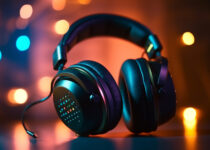Earbuds, Headphones a Rising Threat to Kids Hearing
Protecting Children’s Hearing: How Parents Can Safeguard Their Kids from Noise-Induced Damage
In today’s tech-savvy world, it’s not uncommon to see children as young as five plugged into their earbuds, immersing themselves in music or videos.
However, what many parents may not realize is the potential risk their kids face from prolonged exposure to loud noise through these devices.
The Growing Concern: Young Children and Earbud Usage
Recent findings from the University of Michigan Health C.S. Mott Children’s Hospital National Poll on Children’s Health have raised alarms about the increasing trend of younger children, aged 5 to 12, regularly using earbuds and headphones.
Shockingly, two in three parents report that their children in this age group frequently use listening devices.
Why It’s a Concern
Health experts caution that exposing young ears to loud noises at such an early age can have detrimental effects. Dr. Susan Woolford, a pediatrician at the University of Michigan, highlights that the auditory systems of young children are still developing, making them more vulnerable to harm from noise exposure.
Additionally, their smaller ear canals intensify the perceived sound levels, increasing the risk further.
Understanding the Risks
Hearing Loss and Beyond
Prolonged exposure to high volumes of noise can lead to irreversible hearing loss or conditions like tinnitus, characterized by constant ringing in the ears. Dr. Woolford emphasizes that the risks extend beyond just hearing impairment.

Noise exposure can disrupt sleep patterns, hinder academic learning, elevate stress levels, and even impact blood pressure in children.
Parental Awareness and Action
Despite these risks, the poll reveals a concerning lack of proactive measures by parents to mitigate noise exposure.
Only half of parents surveyed have attempted to limit their children’s use of listening devices. This neglect poses a significant threat to children’s auditory health and overall well-being.
Taking Preventive Measures
Dr. Woolford recommends several strategies for parents to safeguard their children’s hearing:
1. Monitoring Usage
Parents should actively monitor the volume levels on their children’s devices. A simple test: if you can’t converse with your child from an arm’s length away while they’re wearing headphones, the volume is likely too high.
2. Implementing Time Limits
Follow the “60/60” rule: no more than 60 minutes a day with earbuds or headphones, at no more than 60% of the maximum volume. Setting specific hours for device use or using a timer can help enforce these limits effectively.
3. Choosing Safe Devices
When purchasing listening devices, opt for those that emit less than 70 decibels (dBA). Check product information to ensure volume-limiting features are present, prioritizing your child’s safety over marketing claims of being “kid-safe.”
4. Encouraging Device-Free Time
Allocate periods each day for your child to take a break from their headphones and earbuds. Consider storing or locking away devices when time limits are reached to discourage overuse.
5. Exploring Alternatives
Encourage alternative ways of enjoying music, such as playing it at a low volume in their rooms instead of relying solely on earbuds.
Seeking Professional Guidance
If parents notice any signs of hearing loss or are concerned about their child’s auditory health, seeking professional advice from a pediatrician, audiologist, or ear-nose-throat specialist is crucial.
Early intervention can prevent further damage and ensure the child’s well-being.
In conclusion, while technology offers numerous benefits, it’s essential for parents to be vigilant about protecting their children from potential harm.
By adopting proactive measures and fostering healthy listening habits, parents can safeguard their children’s hearing for years to come



